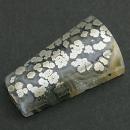|
|
|
|
Click on a letter above to view the list of gems. |
|
|
|
|
|
Marcasite |
|
| Chemistry: FeS2 [Iron Sulfide] | |
| Discovered
in 1845;
IMA
status: Valid (pre-IMA; Grandfathered). | ||
|
| ||
|
Classification |
|
|
| |
|
Sulfides | |
|
2/D.20-10 | |
|
|
2 : SULFIDES and SULFOSALTS (sulfides, selenides, tellurides;
arsenides, antimonides, bismuthides; sulfarsenites, sulfantimonites,
sulfbismuthites, etc.) |
|
Related to: |
Marcasite Group. Marcasite - Iridarsenite Series. Isostructural with Safflorite. A polymorph of Pyrite. |
|
|
|
|
Crystal Data |
|
|
|
|
|
Crystals typically tabular on [010], also pyramidal, prismatic, and, rarely, capillary; curved faces common. Stalactitic, reniform, fine-granular massive; cockscomb and spearhead shapes due to twinning on [101]. |
|
|
Common and repeated on [101]; less common on [011]. Intense twin lamellae development observed in polished section. |
|
|
|
|
|
Physical Properties |
|
|
|
|
|
[101] Distinct, [110] Indistinct (in traces) |
|
|
Irregular/Uneven |
|
|
Brittle |
|
|
6.0 - 6.5 |
|
|
4.887 (g/cm3) |
|
|
None |
|
|
Not Radioactive |
|
|
Other: |
Magnetic after heating |
|
|
|
|
Optical Properties |
|
|
|
|
|
Bronze, light Brass Yellow, Tin White |
|
|
Opaque |
|
|
Metallic |
|
|
None (opaque) |
|
|
None (opaque) |
|
|
None (opaque) |
|
|
Strong; [100] creamy white; [010] light yellowish white; [001] white with rose-brown tint. |
|
|
Very Strong; yellow through light green to dark green |
|
|
Health Warning: |
Marcasite is unstable to metastable and decrepitates, altering to melanterite, which contains sulfuric acid. Always wash hands after handling. Avoid inhaling dust when handling or breaking. Never lick or ingest. |
|
|
|
|
Occurances |
|
|
|
|
|
Geological Setting: |
Typically formed under low-temperature highly acidic conditions, both in sedimentary environments (shales, limestones, and low rank coals) and in hydrothermal veins formed by ascending solutions. |
|
Common Associations: |
Calcite, Dolomite, Fluorite, Galena, Pyrite, Pyrrhotite, Sphalerite |
|
Common Impurities: |
Cu, As |
|
Type Locality: |
n/a |
|
Year Discovered: |
1845 |
|
View mineral photos: | |
|
|
|
|
More Information |
|
|
|
|
|
| |
|
|
|
|
Marcasite was used by the ancient Greeks and was also polished in large slabs by the Incas of Central America. Marcasite was popular in jewelry in the eighteenth century and the Victorian era but is not very popular currently. It is quite brittle and easily broken. Much of the "Marcasite" in antique jewelry is actually Pyrite. Marcasite is slightly unstable, and over a period of years of exposure to air, will oxidize, freeing sulfur which forms sulfuric acid. Over a period of decades, most Marcasite specimens will disintegrated into dust. A sulfur smell released during this reaction is an easy characteristic distinguishing Marcasite from Pyrite. Marcasite
is available from many localities worldwide. |
|
|
We
have not photographed our Marcasite
gems. Please
check back soon. |
